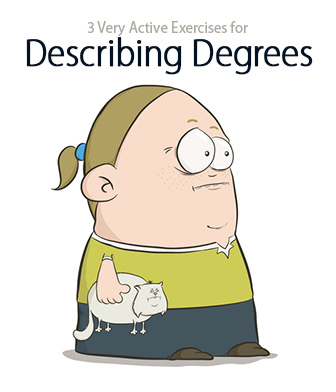
Adverbs of degree can be difficult to approach because they have so many different uses, and the words themselves can be somewhat challenging to define.
You can teach some of them early on, and then continue to introduce more complex uses later on. Try these three very active activities for describing degrees and the results will be utterly amazing.
So what are adverbs of degree anyway? In general they tend to detail the strength or intensity of something that happens. Many adverbs are gradable which means we can give them more or less intensity depending on the situation. For example The little girl is very upset vs. the child is a little upset. Basically they answer questions like how much or how little. Adverbs of degree can be hard to define because they can be used so variably depending on the meaning the speaker is going for. We use them all the time without really thinking about it, and they are often used informally. ESL students should learn where and how to insert them for added meaning, and for naturally intense language. These adverbs can be used situationally for both writing and speaking. The other thing about adverbs of intensity is that there are a lot of them so there's no way you would teach them all. Here are some examples listed out by level:
Beginner: enough, extremely, fully, greatly, a little, mostly, nearly, really, too, totally, very
Intermediate: almost, absolutely, awfully, barely, completely, enormously, entirely, fairly, hardly, incredibly, intensely, partially, pretty, quite, slightly, strongly, terribly
Advanced: adequately, decidedly, entirely, immensely, moderately, nearly, perfectly, positively, practically, profoundly, rather, simply, tremendously, utterly, undoubtedly, virtually
Once these interesting words have been defined, it is important to introduce word placement and rules for use. Adverbs of intensity have many uses, and you won't introduce them all at once. You can begin by explaining that they can modify verbs, adjectives, and other adverbs. When the adverb is modifying a verb, the intensity of the action tends to answer the question how much and is most often placed before the verb. Occasionally the adverb can follow the verb. For example: She really runs fast or Dylan sure eats a lot. When they are used to modify adjectives, they are generally placed in front of a characteristic or quality. For example: John is really handsome. Sally is incredibly graceful. Lastly, adverbs of degree can modify other adverbs and add intensity to answer the question how. For example: Mark drives rather badly. Joe eats extremely poorly.

Useful Activities to Teach or Review Adverbs of Degree
-
1
Guess the Word
This guessing game can be applied for any level, and can be adapted to be simpler or more complex depending on your need. Write out cards with the selected adverbs, and give one to each student. They will take turns silently acting out their word while the class guesses what it is. Give them examples up front because students can get stumped; how would you act out words like rather, simply, or very. An alternative to the charades version, which produces more language, would be to ask students to describe situations where the word would fit (perfectly). They can say anything to get the class to guess correctly. For example: I ate 4 pieces of pizza. I am full, but I didn't eat too much. It was.....(enough). Once the students have guessed all the words they should then create sentences for each word in rounds.
-
2
Create Sentences
Students again get a card with an adverb on it. Give them a few moments of prep time. Then in small groups or pairs, each student creates as many sentences as they can in one minute using the adverb. One student should keep score and also note down any questionable sentences for the whole group to judge. When each student has exhausted all the possibilities within the time limit, have groups swap cards and start again. Ask each student to remember a few favorite sentence creations to report back to the group when reconvened. Students can discuss or point out similarities and differences. Also during the debrief, three big winners should also be announced and rewarded.
-
3
Cut-up descriptions
Cut-up descriptions requires some initial prep time, but once it is done you'll have it for future use. Type up several groups of five to ten sentences using adverbs of intensity. Print them out and cut up the sentences. Mix all the cut up pieces together to form a puzzle. You'll want to create five to ten groups of these, with each one housed in an envelope so you don't lose pieces. Students must piece together the sentences in a given time limit. This activity focuses on correct word order, understanding of particular adverb of degrees, teamwork, and sentence structure. Here's an example: The students are really crazy about their teacher. She is absolutely the funniest teacher in the school. Miss Nadia is absolutely wonderful. John says she is extremely smart. Maria thinks the teacher is very beautiful. Have fun with your descriptions, and include a few student and teacher names or famous people the students like. Before you do this activity in class, have another teacher test it out so you can see how many interesting or funny variable sentences you have. Also be sure to notate the original sentences so you can supply students with the solutions to each puzzle.
Defining and practicing adverbs of degrees can be really enlightening and tremendously fun.
Open up the world of describing degrees and your students will be undoubtedly grateful.
P.S. If you enjoyed this article, please help spread it by clicking one of those sharing buttons below. And if you are interested in more, you should follow our Facebook page where we share more about creative, non-boring ways to teach English.







